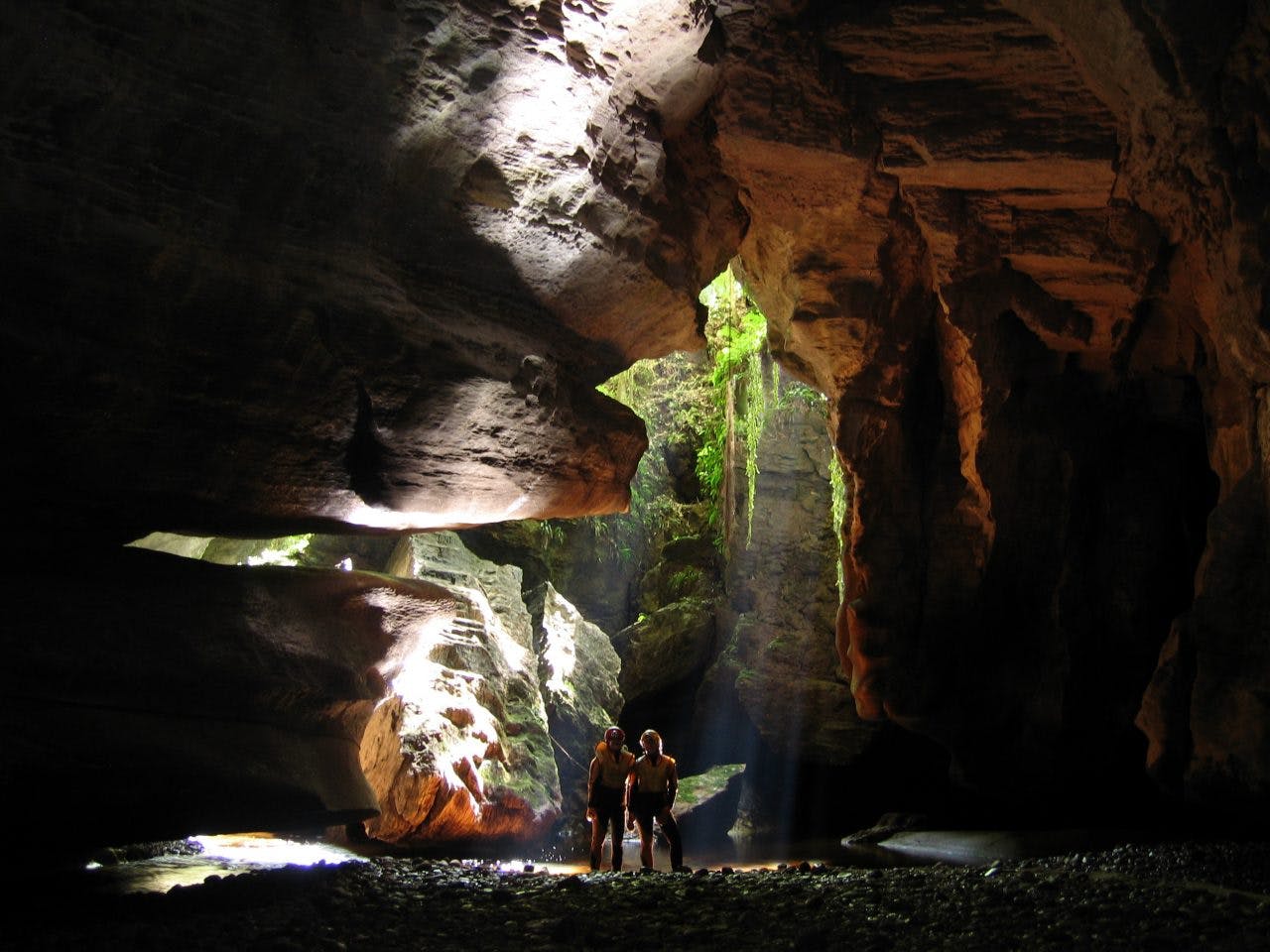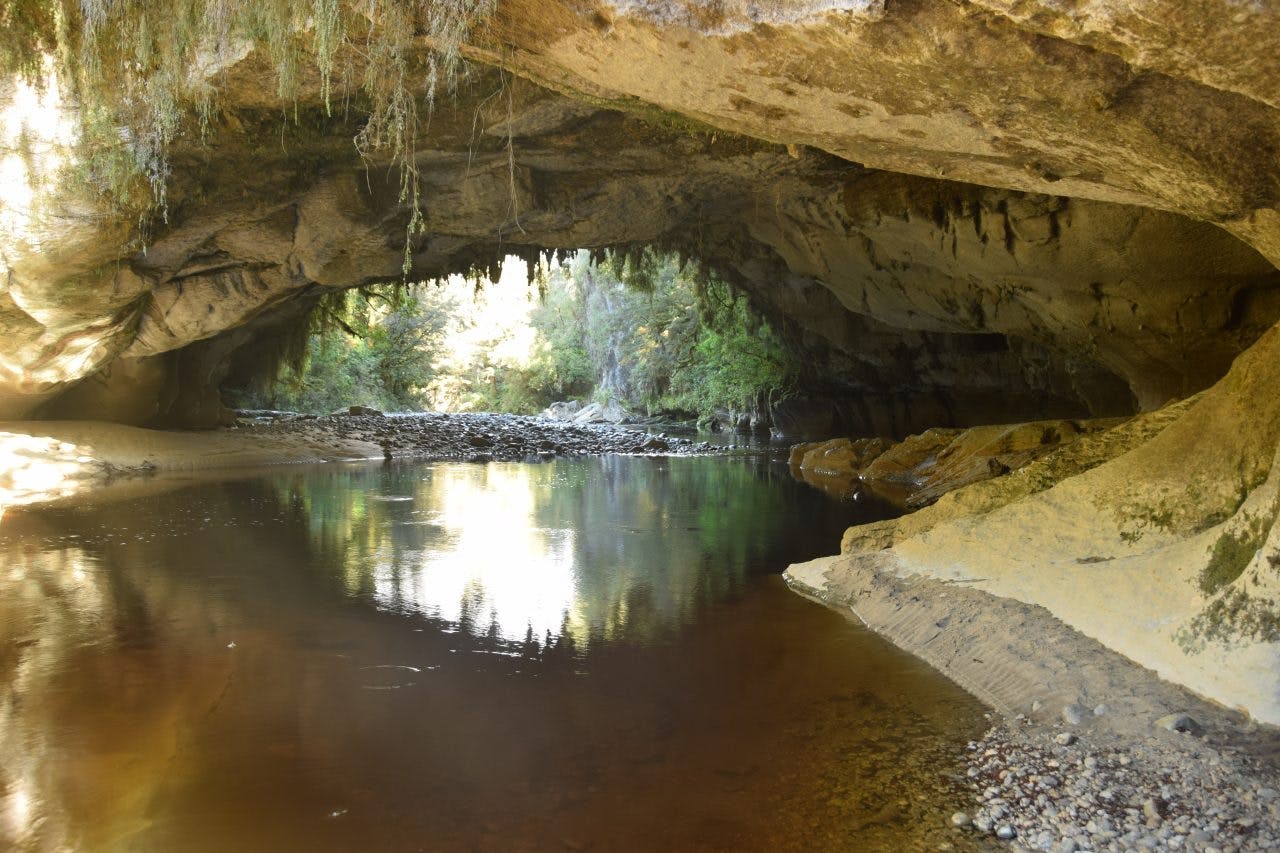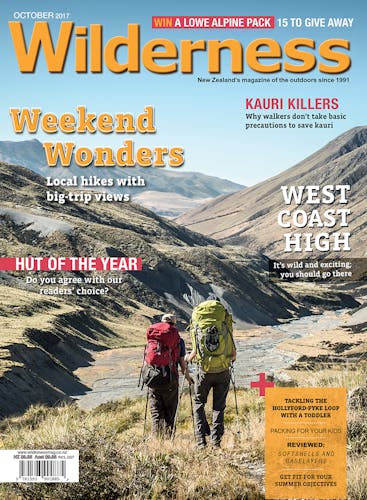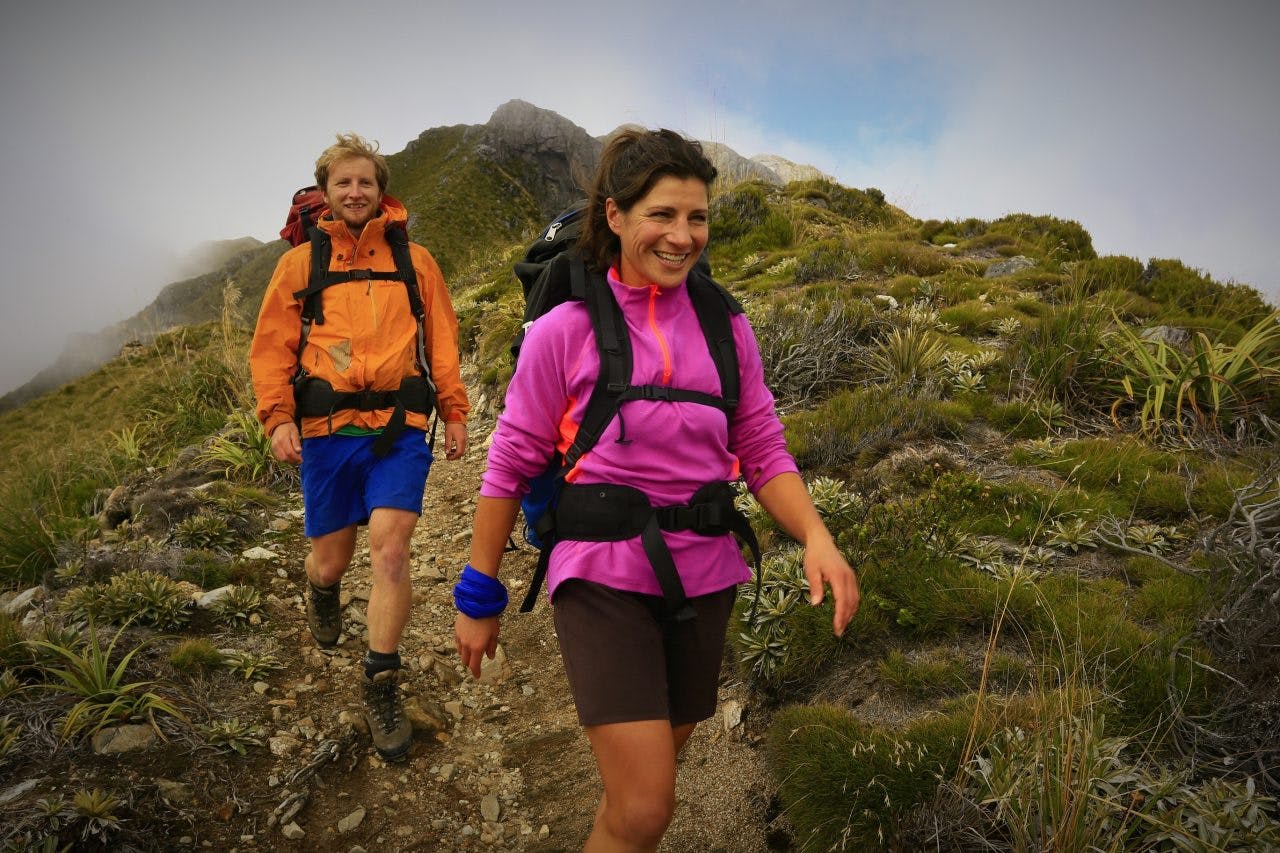The West Coast is an area synonymous with mining, but nowadays trampers, and tourists, are discovering gold in adventurous recreational activities among unrivalled natural features.
Deep beneath the Paparoa Range, in the dust on the Metro/Te Ananui cave system floor, there’s still a few faint footprints and pawprints, their edges outlined in the shadows of our headlamps.
According to Mark, our Underworld Adventures caving guide, they’ve been undisturbed since they were left there in 1963, by a man called Johnny Currie and his dog, Chum. The pair were the first to explore the cave, stepping into the darkness with nothing but a sputtering candle.
Today, however, we have headlamps, helmets, full wetsuits, and a large inner tube that will take us blackwater rafting under a constellation of glow-worms, before a gentle ride down the Nile River and a bush tram back to base. Winter is a great time to visit to escape the summer tourist madness, with the caves drier underfoot and the air a uniform 8-11 degrees – quite warm in a wetsuit. The carefully-managed tour means you’re even up close and personal with helictites: beautiful, rare and gravity-defying formations that are so delicate you’re not likely to see them in bigger tourist caves.
It’s a spectacular, accessible way to experience the wonder of caving, and you’re much closer to the geological features than in more tourist-heavy caving experiences. That’s one of the beauties of adventure tourism on the West Coast: international-quality experiences, but with a warm, local feel.
Back in the 1960s, Currie brought the Metro cave system – and its treasure of kakapo and moa bones – to wider knowledge, and he also happens to be the star of another unique Coast experience: Johnny’s Journey, one of several tours on offer at Outwest Tours.
“This is where you see the real West Coast,” says owner-operator Mickey Ryan, as he drives a rutted track to Currie’s secluded Awakari Valley. We’re about to meet Johnny at his remote tin bush hut, hear about his family history in the valley, and see the herd of wild red deer that roam his land.
Later, near Karamea, Oparara Guided Tours takes me on a walk in the damp, filtered green sunlight of the Oparara Valley, and I marvel at limestone arches and giant kahikatea, rimu and rata. The track has a rejuvenating, other-worldly quality, and after a long car journey north, the rainforest seems super-saturated with oxygen.
“It’s a stunning area, isn’t it?” Oparara Valley Trust chair Rosalie Sampson says. “I always say it’s natural Prozac up there. You might be feeling down, but you go up there and it brings everything back together again.”
On a winter’s day in Westport, it’s easy to find hints of the big businesses that were the heavy hitters in the West Coast economy. There’s that familiar, acrid tinge of coal smoke in the evening. There’s the Solid Energy Centre, Holcim Cement-sponsored walking tracks, and historic remnants of gold-mining tailings dotted over the landscape in scrub-covered hummocks.
But although the mineral sector still contributes massively to the Coast – $230m and 900 jobs in 2016 – the boom and bust extractive industries can no longer be wholly relied upon.
The Coast’s economy has always been heavily dependent on commodities such as coal, gold, and dairy, leaving the area vulnerable to global fluctuations. The gold rush is long past, logging is over, the prices of dairy and coal are down from their highs, the Holcim cement works is closed, and the Pike River tragedy cast a pall over mining, an industry which has also suffered heavy job losses in the past decade.
In November 2015, the West Coast was included in the Government’s Regional Growth Programme as a region with persistent economic under-performance. The Coast’s economic decline over the past 30 years has seen 10,000 people leave. Recently, GDP and employment have contracted, mostly as a result of the decline in dairy and minerals prices. It’s a slow boat to turn around – particularly, Coasters say, when 85 per cent of their land is ‘locked up’ by the Department of Conservation, creating a shallow local ratings pool.

Exploring the underworld attractions on the West Coast. Photo: Underworld Adventures
However, those kilometres of untouched wilderness could also be the centrepiece of a new economic future. Developing the area’s adventure tourism offerings and support industry could help plug the gap left by extractive industries – and in the rugged wilderness of the northern West Coast from Punakaiki to Karamea, operators are organising their tourism efforts.
Tourism development organisation Advance Northern West Coast helps promote the region’s charms. Its chair, Geoff Schurr, began Underworld Adventures in 1987, and he remains a director and shareholder of the company and owns two local motels.
ANWC promotes Westport as the ‘wilderness gateway’ to the northern West Coast, and Schurr says the area is New Zealand’s best-kept secret.
In the early stages of construction, the country’s 10th Great Walk, the 55km, $10m Paparoa Track, will link Blackball with Punakaiki across the Paparoa Range, taking in the existing Croesus Track, Moonlight Route, the Inland Pack Track and Pororari River Track.
A new side track, the 9km Pike29 Memorial Track, will link to the Pike River Mine site. The Great Walk, due to open in April 2019, will be the first to be purpose-built as a dual mountain biking and tramping track, with year-round shared use. The Department of Conservation is projecting up to 2500 walkers a year, with 1000 mountain bikers, and the track will also host two organised sporting or other competitive events a year.
Other tracks in the area are similarly iconic. The stunning Wangapeka Track emerges near Karamea, and the Heaphy Track, from Collingwood to Karamea, has also been open to mountain bikers over winter for several years.
They’re now joined by the Old Ghost Road, an 85km-long hand-built tramping and mountain bike trail, New Zealand’s longest continuous single track. Officially opened in December 2015, the historic gold-miners’ path has become justifiably famous, raved about by trampers and riders from around the world.
It’s popular too; first year numbers hit 9000, much more than expected, with 95 per cent of respondents in one survey indicating the trail was their main reason for visiting the West Coast. It runs from Lyell to Mokihinui, traversing incredible country with spectacular views. An ultramarathon now takes place on the track, too.
“Traditionally we’ve been undersold, but we over-deliver,” Schurr says. “The northern region has been the poor partner to our big glaciers down south, and so not as many people know of the attractions up here. The major extractive industries are going and we’re now looking to utilise our scenic attractions and activities.”
The potential for adventure tourism, he says, is “huge”.
“At the moment, we’ve got heaps of spare capacity. There are very few days that we’re booked out, whereas down south they have a lot of trouble now fitting people in.”
There are plenty of transport links for tourists – Air New Zealand pulled out of Westport in 2015, but Sounds Air flies to Westport three times a day from Wellington, and Air Charter Karamea will be in operation from November this year. Schurr says the main barrier to growth is the time frame people set for their Coast trip.
“They need to take more time or change their itineraries to come north rather than just whistle through the place. If they slow down, they’ll see something pretty special.”
Compared to some of New Zealand’s more developed adventure tourism centres, experiences on the Coast are down-to-earth and personal, taking in the West Coast’s unique history and frontier character. Supporting these activities is a range of new and refreshed accommodation, much of which takes full advantage of stunning coastal views, and owners say they are catering to a more discerning traveller – and hopefully enticing them to stay.
On the way to Karamea, Granity was once a thriving coal-mining, gold and logging village, but today it’s a settlement more focused on tourism. Local pub, Miners on Sea, was built in 1892, but it’s recently turned away from the pub trade; like other country pubs around New Zealand, dollars have been dwindling due to lowered drink driving limits as well as Kiwis’ increasing preference to drink at home.
A bar and liquor store are still there, but so are local arts and crafts, as well as the excellent Tommy Knockers Café, facing out to the Tasman Sea. Mine workers are still regulars, but beside the pub is a series of newly built self-contained boutique chalets, complete with woodburners, verandas and a short stroll to the beach. Cheaper ‘pod’ rooms are built around a central bathroom. The idea, owner Phil Perrott says, is to provide a better experience than traditional backpackers. He and wife Rona have found it’s also been great for mountain bike groups.

Oparara Arches. Photo: Brenda Turner
Down the coast, Carters By the Sea, near Westport, is an upmarket collection of stylish accommodation apartments that would satisfy any choosy traveller, overlooking the splendor of Carters Beach. At Cape Foulwind, Karen and Lee Forsman are recent new owners of Omau Settlers Lodge, another collection of modern, comfortable lodges that are rated number one in the West Coast on TripAdvisor.
“There’s been a shift in Westport towards realising it’s not just a service town but a really good central hub for visitors to explore the northern West Coast, and we need to be gearing ourselves up for tourism,” Karen says. “And it’s starting to pay off for sure.”
The pair are looking forward to seeing more activities in place, such as the 45km Kawatiri Cycleway from Westport to Charleston, which will take cyclists and walkers around the coastal area of Buller, crossing the Nile and Totara rivers, Okari Lagoon, Tauranga Bay and Cape Foulwind. Visitor numbers are expected to hit 25,000 a year by 2025.
“That’s going to open up so many more opportunities for people to stay and enjoy what we have on offer.”
She echoes Schurr when she says people don’t realise what’s here until they arrive. The nearby Cape Foulwind seal colony attracts 200,000 visitors every year, but Forsman says they often stop in to visit the seals and then take off again.
“What we’ve noticed with the guests that stay here is that they realise there’s so much more they wanted to do after the fact. By the time they’ve booked their accommodation they’ve already booked their itinerary. So it’s trying to spread the word that there is a lot to do here.”
Buller mayor Garry Howard says adventure tourism is “a really strong performer” in the area, as well as adventure sports and competitions: challenging running, cycling, and watersport events.
They’ve been fortunate to tap into the Government’s infrastructure funds, he says, but “there’s a lot more to it than that”.
“It’s not just the establishment of the infrastructure, but it’s the ongoing costs. It falls to ratepayers to supply water, collect rubbish and provide toilet facilities, and I think there’s a lot more acknowledgment of the cost of tourism for small rural communities with small populations.”
A recent study was commissioned in response to the troubling economic conditions of the past few years. The Tai Poutini West Coast Regional Growth Study, released in September last year, identified tourism as the ‘major immediate opportunity to increase investment and employment in the region’, saying some of the Coast’s key assets included its resourceful people, ‘spectacular natural assets’ and abundant resources that will help support stronger employment and income growth in the future.
The report sets a goal of increasing visitor arrivals from 870,000 to 1.1m by 2021, extend the average length of stay from two to 2.7 nights, increase visitor spending from $470m to $810m, and increase tourism employment from 2000 to 2500. Indeed, tourism is doing exceptionally well, and this year the West Coast Regional Council picked up an award for the success of its ‘Untamed Natural Wilderness’ brand. Between February 2016 and February 2017, West Coast tourism expenditure was up by 13.1 per cent ($61 million), compared to 9.1 per cent for the South Island, with bed nights increasing by 85,170. A 0.4 per cent increase in tourism market share, from 5.1 to 5.5 percent, reversed six years of losses.
The growth study is complemented by the $36.5m Tai Poutini West Coast Economic Development Action Plan, which in July this year set out how to tackle the opportunities with seven of the 14 initiatives around tourism. It notes that the nationally significant natural landscapes and wilderness experiences that are central to West Coast tourism were potentially in conflict with extractive industries, acknowledging ‘clear tensions’ between economic development and the management of natural resources.
Mayor Howard agrees that keeping the environment well protected is crucial to the area’s fortunes – as well as benefitting wider New Zealand.
The Oparara Arches, north of Karamea, is a priority in the plan, and Rosalie Sampson says a potential upgrade is going through its process, with a feasibility study done by December, and then a business case.
“My view is it would be the most wonderful thing that could happen,” she says. The upgrade would include tracks, interpretation areas, and predator control, focusing on the ‘lost world’ aspects of the area and its human history of logging.
“One of our sayings is we have to use our past to secure our future,” she says. “We used to have logging, but we’ve done away with that now, and we’ve just got to make tourism our future. It’s an area well worth promoting. It’s magic.”
– Naomi Arnold visited the West Coast with the assistance of Air Charter Karamea and ANWC.








